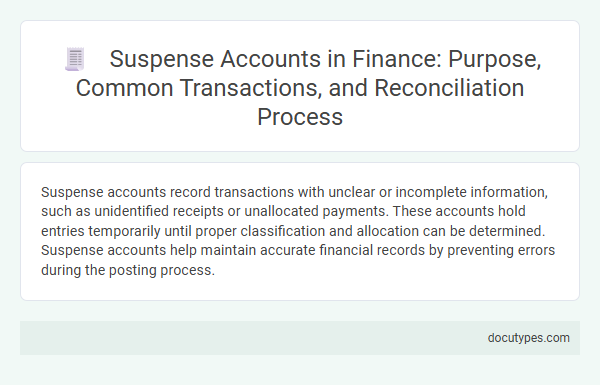Suspense accounts record transactions with unclear or incomplete information, such as unidentified receipts or unallocated payments. These accounts hold entries temporarily until proper classification and allocation can be determined. Suspense accounts help maintain accurate financial records by preventing errors during the posting process.
Introduction to Suspense Accounts in Finance
Suspense accounts serve as temporary holding places for transactions that cannot be immediately classified in the financial records. They ensure accuracy by isolating uncertain entries until proper allocation is determined.
Common transactions recorded in suspense accounts include unidentified payments, incomplete customer information, or discrepancies in ledger balances. This prevents errors in financial statements while awaiting clarification or further investigation.
Definition and Role of Suspense Accounts
Suspense accounts temporarily hold financial transactions with unclear or incomplete information until proper classification is determined. These accounts play a critical role in ensuring accounting accuracy by preventing misstatements in financial records.
- Unidentified Transactions - Transactions lacking sufficient details are recorded in suspense accounts to await further investigation.
- Incorrect or Ambiguous Entries - Entries with conflicting or missing data are placed in suspense accounts to avoid errors in financial statements.
- Pending Verification - Transactions pending confirmation or approval are held in suspense accounts to maintain ledger integrity.
Common Purposes of Using Suspense Accounts
Suspense accounts temporarily hold uncertain or unclassified financial transactions until their proper classification is determined. These accounts ensure accounting records remain accurate by isolating ambiguous entries during the reconciliation process.
Common purposes of using suspense accounts include managing discrepancies in bank reconciliations, recording transactions with insufficient information, and handling unallocated payments. They act as a holding area for transactions pending further investigation or clarification. Once the correct accounts are identified, entries are transferred from the suspense account to their appropriate ledger accounts, maintaining financial statement integrity.
Types of Transactions Recorded in Suspense Accounts
What type of transaction is recorded in suspense accounts? Suspense accounts temporarily hold transactions with unclear or missing information. Common types include unidentified payments, unallocated receipts, and incomplete entries awaiting clarification.
Examples of Suspense Account Entries
| Type of Transaction | Explanation | Examples of Suspense Account Entries |
|---|---|---|
| Unidentified Receipts | Funds received without clear details or proper documentation. | Customer payment received but unclear which invoice to apply; Bank deposit lacking remittance advice. |
| Unclassified Payments | Payments made with missing or incomplete information on the purpose or beneficiary. | Cheque issued without a supporting invoice number; Utility bill payment with ambiguous reference. |
| Discrepancies in Account Balances | When trial balance or ledger balances do not match, causing temporary holding of the difference. | Adjustment amounts pending reconciliation of bank statement errors; Differences discovered during month-end closing. |
| Suspended Transactions Pending Clarification | Transactions entered temporarily until proper classification is determined. | Advance payment received without customer details; Partial payment recorded awaiting confirmation. |
| Incorrect Posting | Transactions recorded in wrong accounts require temporary transfer to suspense account. | Journal entry with uncertain account coding; Misposted vendor payment held for correction. |
If you encounter unexplained or ambiguous transactions in your financial records, placing them into a suspense account ensures that your accounting system remains accurate until proper investigation and allocation occurs.
Importance of Suspense Accounts in Financial Reporting
Suspense accounts are used to temporarily record transactions when there is uncertainty about their proper classification or incomplete information. These accounts hold unallocated funds, unidentified receipts, or discrepancies until the correct accounts can be determined. Your financial reporting accuracy depends on promptly clearing suspense accounts to ensure all transactions are properly categorized and reflected in the financial statements.
Steps in the Suspense Account Reconciliation Process
Suspense accounts temporarily hold uncertain or unclear financial transactions until their proper classification is determined. Reconciling these accounts ensures accurate financial reporting and prevents discrepancies.
- Identify Transactions - Review all entries recorded in the suspense account to determine which transactions lack adequate information or proper documentation.
- Investigate and Classify - Analyze each transaction to gather missing data, verify details, and decide the appropriate ledger account for accurate recording.
- Adjust Entries - Transfer transactions from the suspense account to their correct accounts, then clear the suspense balance to maintain accurate financial statements.
Best Practices for Managing Suspense Accounts
Suspense accounts temporarily hold transactions with unclear or incomplete details to ensure accurate financial reporting. Managing these accounts efficiently reduces errors and improves reconciliation processes.
- Unidentified Payments - Transactions lacking proper identification are recorded in suspense accounts until verified.
- Partial or Incomplete Entries - Entries missing essential data such as account numbers or amounts are deposited here.
- Discrepancies in Balances - Differences found during account reconciliation are held in suspense accounts pending resolution.
Your best practice includes regularly reviewing suspense accounts to promptly clarify and reclassify transactions, maintaining accurate and transparent financial records.
Common Challenges with Suspense Account Reconciliation
Suspense accounts record transactions with unclear or incomplete information, often acting as temporary holding accounts until proper classification is determined. Typical entries include unidentified receipts, unmatched payments, or discrepancies in ledger balances.
Reconciling suspense accounts poses challenges due to missing documentation and ambiguity in transaction origins. Frequent errors occur from delayed identification, causing prolonged misstatements in financial records and complicating audit processes.
What Type of Transaction Is Recorded in Suspense Accounts? Infographic

